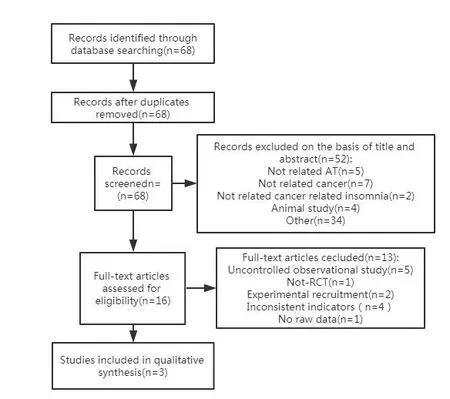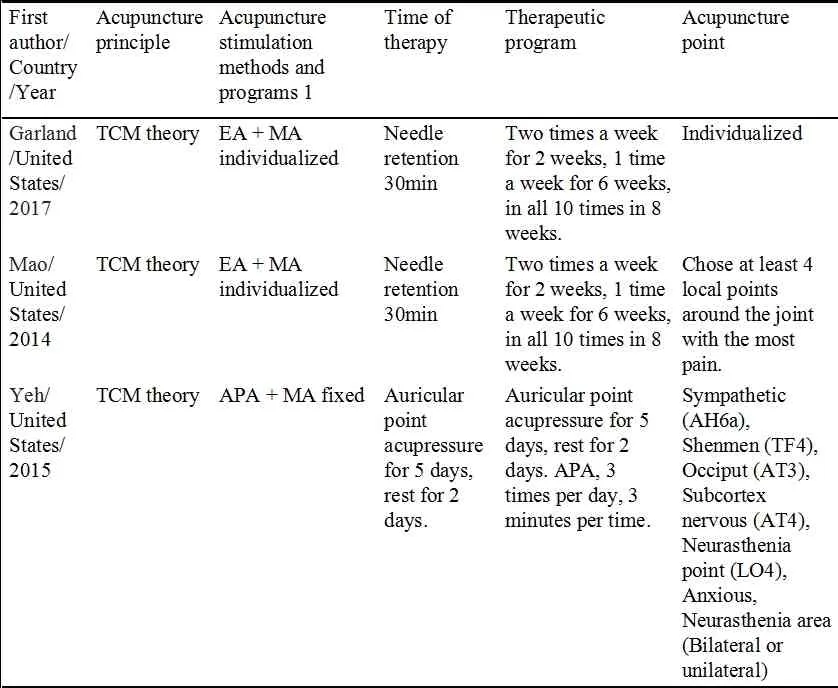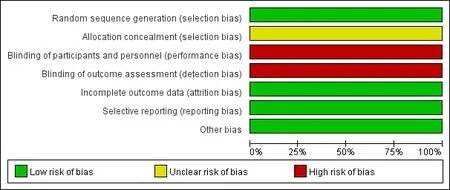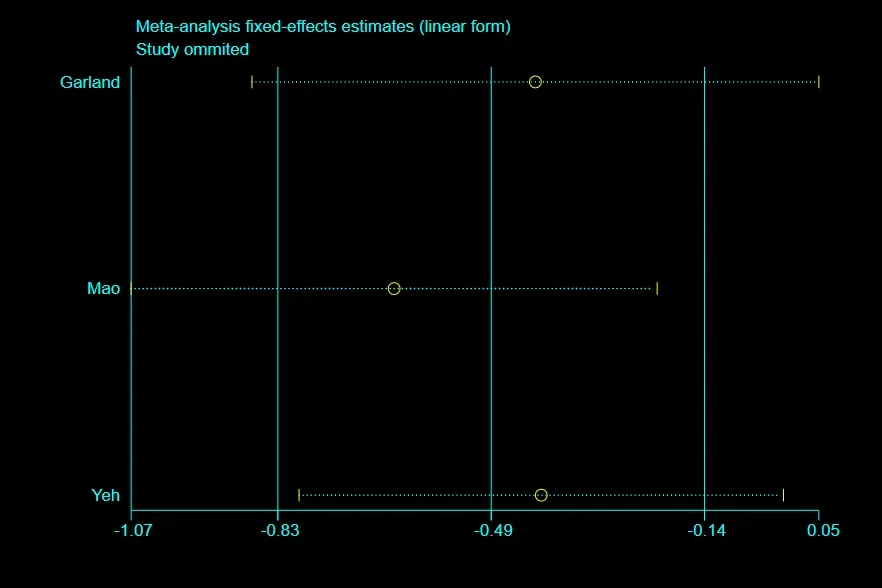A meta-analysis of the treatment of cancer-related insomnia with acupuncture
2020-03-09XueWeiQiManJingPanTianYanWen
Xue-Wei Qi, Man-Jing Pan, Tian-Yan Wen*
1Department of T.C.M., Shenzhen Longgang Central Hospital, Shenzhen, China.
Keywords: Randomized controlled trials, Cancer-related insomnia, Traditional Chinese medicine, Acupuncture
Introduction
The incidence of insomnia in tumor-related diseases accounts for 18%-68% [1, 2]. Such kind of tumor-related sleep disorder, also known as cancer-related insomnia (CRI), is a common sleep disorder which is common among cancer patients [3]. As reported, up to 50% of cancer patients show sleep disorders such as difficulty falling asleep, multiple awakenings during the night, etc., compared to 15% of the general population [4]. Because patients and their treatment teams often ignore or neglect them [5], they are prone to develop into chronic insomnia [6, 7]. Studies have also shown that insomnia often interacts with fatigue, pain, depression and other factors, affecting the treatment effect and later recovery [8-11]. Therefore, it becomes more and more important in clinical treatment.
At present, the preferred treatment for insomnia is drug therapy, and the most commonly used drugs are benzodiazepines and non-benzodiazepines [12]. However, there will always be some inevitable side effects that affect its clinical application [13, 14]. Therefore, in order to improve the sleep disorder of cancer patients, doctors often supplement it with other treatment methods, such as traditional Chinese medicine [15], acupuncture [16], cognitive behavioral therapy [17], Tai Chi [18], etc., among which acupuncture [19] is relatively widely applied.
Acupuncture is widely inherited and developed in today's society. As a unique disease treatment method in China, it has a long history, with the characteristics of wide indications, obvious curative effect, convenient operation, economic security, etc. The main purpose is to adjust the functions of Zang-fu organs (in traditional Chinese medicine, the heart, liver, spleen, lung and kidney are called the five Zang; stomach, gallbladder, large intestine, small intestine, bladder and Sanjiao are called the six Fu.), meridians and acupoints by means of the conduction of meridians and acupoints, and to achieve the purpose of treating diseases by using certain operation methods. In the narrow sense, acupuncture only refers to acupuncture and moxibustion, in which acupuncture is the method of inserting various metal needles into specific acupoints and using different techniques to treat diseases, while moxibustion is the method of treating diseases by burning acupoints after getting moxa sticks and moxa cone ignited. In the broad sense, acupuncture also includes auricular acupuncture therapy, scalp acupuncture therapy, electroacupuncture, cupping therapy and so on. A retrospective analysis has shown that acupuncture can improve or relieve cancer symptoms and/or complications through some mechanism, such as pain, nausea and vomiting, anxiety, fatigue, insomnia, etc [20]. A prospective analysis also provided support for acupuncture to improve sleep disorders [21]. Currently, there are few systematic evaluations on acupuncture and CRI. A Mata analysis showed through six RCTs that acupuncture may be more effective than sham acupuncture, conventional drugs and hormone therapy in the treatment of CRI [22]. A meta-analysis and systematic evaluation showed that it was still unclear whether acupuncture and its related methods were effective in treating insomnia among cancer patients [23, 24]. With more and more applications of acupuncture in the treatment of CRI, it is particularly important to evaluate its therapeutic effect. Therefore, this paper only searched the randomized controlled trials on Pubmed in recent years on the treatment of CRI through acupuncture-related methods to evaluate the therapeutic effect of acupuncture on CRI, so as to provide a reference for the treatment of CRI through acupuncture.
Materials and methods
Inclusion criteria
Research type. This systematic review includes randomized controlled trials (RCTs) and quasi-randomized controlled trials (quasi-RCTs). If any of the acupuncture-related treatment methods were used as the sole intervention or as an adjunct to another treatment for CRI, and the control group received the same treatment as the therapy group, the study was included.
Object of study. The objects of study were all patients diagnosed with insomnia caused by cancer.
Intervention type. The acupuncture intervention methods include ordinary acupuncture, electroacupuncture, scalp acupuncture, aricular acupuncture, moxibustion, etc. The therapy group was treated with either acupuncture intervention alone or in combination with other therapies for insomnia, while the control group was treated with other therapies for insomnia. Among them, acupuncture intervention mode and cycle description are detailed, and the type of intervention method, selected acupoints, operation time and course of treatment are not limited. Other therapies refer to other therapies that exclude acupuncture, such as scalp acupuncture, aricular acupuncture, moxibustion and so on. There is no limitation on the category, and the course of treatment is the same as the therapy group.
Results. 1)Assessment scales: pittsburgh sleep quality index (PSQI), M.D. Anderson symptom inventory (MDASI), Hamilton depression scale (HAMD) and other sleep quality assessment scales or indicators; 2)sleep efficiency, that is, the ratio of total sleep time to bedtime can be determined by both subjective and objective methods; 3)adverse reactions.
Exclusion criteria
1) Insomnia caused by other reasons; 2)redundant publication of the same study; 3)exclude studies with inconsistent outcome indicators; 4)exclude case studies, qualitative studies, uncontrolled studies, and controlled trials without randomized methods.
Search strategy
A Pubmed database was searched by computer for clinical randomized controlled trials and semi-randomized controlled trials related to acupuncture in the treatment of CRI. The search data is from database construction to April 1, 2019, and the search term is abstract (acupuncture OR electro-acupuncture OR acupoint OR scalp needle OR ear acupuncture OR moxibustion OR fire needle) AND (cancer OR tumor OR neoplasms OR malignancy OR carcinoma) AND (sleep disorder OR sleep disturbance OR insomnia OR wakefulness). In addition, the references of the study were also retrieved to reduce the possibility of missed detection.
Literature screening
It was completed by two independent bibliographers respectively. According to the formulated inclusion and exclusion criteria, the pieces of literature that did not meet the criteria were first excluded by means of the titles and abstracts retrieved through reading, and the remaining literatures were screened through reading the full text. In case of any dispute in the inclusion process, the decision shall be made by two bibliographers through discussion.
Information extraction
Information extracted from the included literatures mainly includes title, the first author, year of publication, random method, blind method, intervention measures, sample size, outcome indicators, adverse events, etc. For some studies that are difficult to obtain relevant data, contact should be made with the original study author as far as possible to obtain the required data, so as to extract the relatively accurate specific numerical value of each measurement indicator. However, for literature where original data are not available and the author cannot be contacted, the research data of this indicator is regarded as invalid and excluded. The information extraction is carried out independently by two evaluators and then crosschecked. If there is any disagreement, it can be solved through discussion.
Quality evaluation
The Cochrane risk of the bias assessment tool is the consensus of the methodologists, editors, and system evaluators of Cochrane Collaboration, as well as the risk of bias assessment tool recommended by the Cochrane handbook, which has a clear structure and is easy to use. In this study, the Cochrane risk of bias assessment tool was used to conduct the methodological quality evaluation of the included studies. The specific evaluation method was based on the Cochrane risk of bias assessment criteria [11] in the Cochrane risk of a bias assessment tool. It mainly includes 1)Selection bias: Random sequence generation, allocation and hiding; 2)implementation bias: Subjects and researchers were blinded; 3)measurement bias: Blind evaluation of research results; 4)follow-up bias: Integrity of outcome data; 5)report bias: selective reporting of research results; 6)other biases: other sources. As for the above six aspects, the judgment of low risk, unclear risk and high risk are made. The quality evaluation was conducted independently by two reviewers and then crosschecked. In case of any disagreement, it shall be settled through discussion.
Data analysis
The statistical software RevMan 5.3 was used to conduct statistics on the collected data. In the effect size calculation, odds ratio (OR) was used as the efficacy analysis statistics for the counting data, and mean difference (MD) or standardized mean difference (SMD) was used for the continuous variable data to represent the effect size, and a 95% confidence interval (95% confidence intervals, 95% C) was used as the effect size to represent the results; First of all, the heterogeneity test was conducted on the included literatures, and the heterogeneity was estimated based on the heterogeneity test results, P-value and I2 statistics. The fixed-effect model or random effect model was selected to obtain the effect combination value. If P > 0.1 and I2≤ 50%, multiple independent studies are considered to have no statistical heterogeneity, so the fixed effect model is adopted; If P ≤ 0.1 and I2> 50%, statistical heterogeneity can be considered to exist in multiple independent studies, and the causes of heterogeneity can be analyzed. The heterogeneity treatment methods such as sensitivity analysis or subgroup analysis can be used to achieve homogeneity, and then the fixed-effect model can be used. If the results of multiple independent studies are still not homogeneous after heterogeneity analysis and treatment, the random effect model shall be adopted for analysis. The results of the meta-analysis were presented in a forest plot and, where possible, we used an inverted funnel plot to evaluate publication bias.
Results
Literature screening results and the basic characteristics of inclusion in the studies

Figure 1 Literature inclusion and exclusion process
Through the above search strategy, a total of 68 literatures were searched. Through browsing the titles and abstracts, 52 literatures were excluded (16 were left). Through further reading, 12 literatures were excluded based on the inclusion and exclusion criteria, and there was one literature for which the original author could not be contacted, so the specific value was relatively not accurate. 3 articles [25-27] including 3 clinical randomized controlled trials, and a total of 165 patients were selected as candidates, and finally, 133 cases were included in the meta-analysis. It was in 2014, 2015 and 2017; The sample size was 31 cases, 58 cases and 76 cases respectively; The three included studies were all from the United States; The disease type was all breast cancer; The acupuncture methods include electroacupuncture and auricular point sticking, including 2 for electroacupuncture and 1 for auricular point sticking alone; The time of therapy was 30min for electroacupuncture except for 5 days for auricular point sticking; The treatment course ranged from 4 weeks to 8 weeks; The outcome criteria for treatment outcome included PSQI and MDASI scales. (Figure 1, Table 1, 2).
Literature quality evaluation
As for the quality methodology evaluation of the included literatures (Figure 3), the three literatures all met the low risk of bias (> 4 points) and were of high quality. (Figure 2) is a statistical chart of the proportions of each item in the methodological evaluation.

Table 1 Summary characteristics of included randomized clinical studies

Table 2 Details of acupuncture procedure
Heterogeneity test
The three literatures in this study were tested for heterogeneity, in which I2= 45% < 50%, and P > 0.1 in the Q test, which indicated that there was no heterogeneity among the selected literatures, so fixed effects could be selected for meta-analysis.
Sensitivity analysis
Sensitivity analysis was conducted on the three literatures (Figure 4). It can be seen from the figure that none of the literatures exerts a great influence on the research results and heterogeneity.
Meta-analysis for fixed effects
The indicators used in this study were the reduced scores of the experimental group and the control group relative to the baseline (Figure 5). The sleep score of the experimental group was decreased by 0.48 more than that of the control group, with a 95% confidence interval of -0.82 to -0.13, and the degree of decrease was statistically significant, Z = 2.70, P < 0.05.
Funnel plot
The funnel plot was used to investigate whether there was a publication bias in this study. Funnel plot symmetry means there is no publication bias (Figure 6). Furthermore, Begg's Test was conducted on the above figure, and P = 0.602 > 0.05 was obtained, indicating that the funnel plot was symmetrical, so it could be judged that there was no publication bias in the literatures of this study.

Figure 2 Literature quality evaluation summary
Discussion
With the increasing number of cancer patients and cancer survivors year by year [28], cancer-related diseases have gradually attracted people's attention, and insomnia is one of the reasons for survivors' distress. Acupuncture as a non-drug therapy of traditional Chinese medicine is often mentioned [19]. As a unique disease treatment method in China, acupuncture has a long history, with the characteristics of wide indications, obvious curative effect, convenient operation, economic security, etc. The main purpose is to adjust the functions of Zang-fu organs, meridians and acupoints by means of the conduction of meridians and acupoints, and to achieve the purpose of treating diseases by using certain operation methods. However, the mechanism of its action in treating insomnia is still unclear. Studies have shown that acupuncture may have therapeutic effects by altering norepinephrine, 5-hydroxytryptamine, histamine, dopamine, acetylcholine and other neurotransmitters [29]. The World Health Organization considers auricular medicine to be a form of microneedles with therapeutic effects on the whole body, so it is used as a screening method [27]. In this study, except for one literature that failed to obtain effective original data, four randomized controlled trials were excluded since the outcome indicator was the final treatment data, and only three effective literatures were finally obtained. After the literature quality evaluation, these three literatures all reached the low risk of bias with high quality, and there was no heterogeneity among the literatures. Three included randomized controlled clinical trials were used to analyze the efficacy of acupuncture in the treatment of cancer insomnia with evidence-based medicine, that is, to observe the reduced scores of the two groups after treatment compared to those at baseline. The results showed that the sleep scores in the experimental group were lower than those in the control group, indicating that acupuncture-related therapies including electroacupuncture and auricular acupuncture could better improve CRI. This suggests that we should increase the application of acupuncture therapy in future clinical applications, which also confirms its research from another perspective [30]. Moreover, the indicators used in this study are the scores decreased relative to the baseline, and the result has a certain credibility. Although the research analysis showed that acupuncture-related therapy may better improve CRI, in the two studies on the application of electroacupuncture in the treatment of breast cancer, the treatment method was 1 time/week, which is quite different from the conventional treatment of insomnia in China (in China, it is usually 1 time/day, with a course of treatment of 30 days). Therefore, researchers are not very comfortable with this treatment, so this may also limit its clinical efficacy [26, 31]; Of course, the treatment of auricular point sticking is relatively in line with China's clinical treatment. However, there are still certain limitations in our studies. First of all, the searched scope of literatures is only limited to the Pubmed database. Although it is believed that the search can ensure that relevant data we need can be found, it does not include the large database of CNKI (China National Knowledge Infrastructure) that applies acupuncture to treat CRI in China. The purpose of this study is to observe the clinical applications of acupuncture in this disease in published foreign literatures; Secondly, although the selected literatures were of high quality and low risk of bias, and there was no heterogeneity among the literatures, they were small in number. On the one hand, they might affect potential publication bias, but they also suggested that we could make further studies in this direction in the future; Thirdly, the three included RCTs were all from the United States for the treatment of breast cancer, so the results were limited to some extent in the expanded application of other cancer treatment in other countries. Finally, the nature of the reported results is mostly subjective, and these tend to be potential biases in the studies. Therefore, the implementation of scientific design, rational randomized method, compliance with clinical practice, and multi-center, large sample and high-quality randomized controlled trials are very important to confirm the efficacy of acupuncture in this disease. However, a meta-analysis also showed [32] that cancer patients lacked a correct understanding of certain aspects of acupuncture in the treatment of diseases, which made most patients only recognize the efficacy of acupuncture in treating physical symptoms or conditions caused by cancer, and lack confidence in the treatment of mental disorders such as insomnia. Therefore, when we try to evaluate the therapeutic effect of acupuncture, we should also actively explain the therapeutic effect of acupuncture on patients, so as to improve its clinical applications.In conclusion, this study only indicates that related acupuncture treatment methods may be more effective in improving the clinical outcomes of patients with CRI. Although the included literatures feature low bias and no heterogeneity, the quantity may have reduced its clinical significance. Therefore, more studies on high-quality randomized controlled trials should be conducted in the future, so as to better specify the therapeutic effect of acupuncture on CRI.

Figure 3 The chart of the proportions of each item in literature methodology quality evaluation

Figure 4 The results of Sensitivity analysis

Figure 5 Meta-analysis for fixed effects

Figure 6 Funnel plot
杂志排行
Life Research的其它文章
- Drug-related problems among type II diabetes mellitus patients with hypertension: a cross-sectional study
- Combined music and play therapy resolves chronic toddler sleep issues: a case report
- Contrasting cognitive behavioral therapy for insomnia to analyze sleep theory in Laolao Hengyan
- A review of the treatment for insomnia in patients with cancers
- A review on the effects of sleep duration on hypertension
